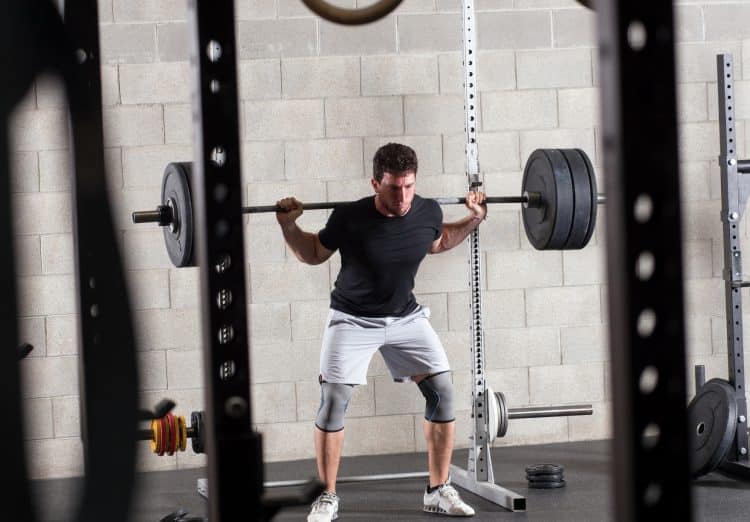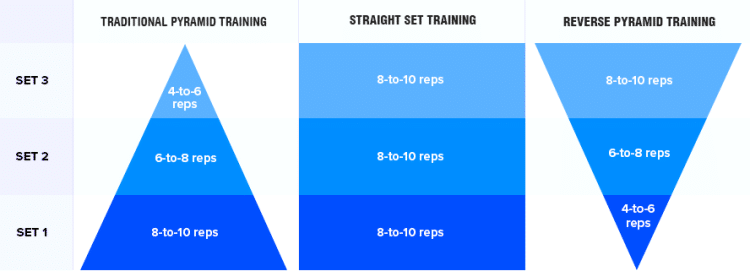Are you stuck in a progress rut or bored of doing the same types of workouts? Try pyramid training!
Most strength and bodybuilding workouts are based on a system called straight or regular sets. With this programming method, you do several sets of a similar number of reps using the same load. For example, four sets of eight to ten reps with 135 pounds/60 kilograms.
And while such a conventional training method can be effective, it’s not the only way to organize your workouts. In fact, doing the same type of training over and over again can soon become boring and less effective.
Bodybuilders and other strength trainers use alternative ways (often known as training systems) to make their workouts interesting and productive. One such way is pyramid training. While there are several variations of pyramid training, the basic concept involves varying your weight and reps from set to set to expose your muscles to a range of training intensities. This approach can lead to increased muscle growth and strength gains.
Related: Sets vs. Reps – Everything You Need to Know
In this article, we discuss what pyramid training is, different ways to use it, and provide you with some sample workouts to try.
Level Up Your Fitness: Join our 💪 strong community in Fitness Volt Newsletter. Get daily inspiration, expert-backed workouts, nutrition tips, the latest in strength sports, and the support you need to reach your goals. Subscribe for free!
Ready to take your workouts to the next level? Well, buckle up because it’s time to try pyramid training!
Types of Pyramid Training
Pyramid training involves changing your exercise load and the number of reps performed set-by-set. However, there are several interpretations of pyramid training, and it’s essential to use the best one for your fitness, strength, and muscle-building goals.

Popular pyramid training methods include:
1. Ascending Pyramid Training
The only way is up with ascending pyramid training. This is probably the most well-known and widely used variation of pyramid training. With this method, you start with a light weight and perform high reps. Then, with each passing set, you lift more weight but for fewer reps.
Example:
- 12 reps – 40 pounds
- 10 reps – 60 pounds
- 8 reps – 80 pounds
- 6 reps – 100 pounds
Benefits:
- A built-in warm-up.
- You can easily modify the pyramid based on how you’re feeling.
- Suitable for all levels of exercisers.
- Good for general fitness and bodybuilding training.
Drawbacks:
- Fatigue will limit the amount of weight you can use toward the end of the pyramid.
- Not ideal for building maximal strength.
- Using too broad a rep range, e.g. 20-6, will negate some of the benefits of this method.
Descending Pyramid Training
Descending (or reverse) pyramid training flips this workout method on its head, so you do your heaviest weight/lowest reps first, then decrease the load and do more reps set by set. As such, this method is sometimes called heaviest set first training.
Example:
- 6 reps – 120 pounds
- 8 reps – 100 pounds
- 10 reps – 80 pounds
- 12 reps – 60 pounds
Benefits:
- Makes the most of your energy by putting the heaviest sets first.
- Sets get easier as fatigue sets in.
- Suitable for building maximal strength or muscle mass.
- The initial heavy set primes your nervous system, so you may be able to do more reps in subsequent sets compared to an ascending pyramid.
Drawbacks:
- Usually requires a lengthy warm-up.
- Jumping straight into a heavy weight can be off-putting for some.
- Not ideal for beginners.
3. Ascending/Descending Pyramid
What does up must come down with this pyramid training variation. You start with an ascending pyramid, but instead of stopping when you reach your peak, you reduce the weight and do fewer reps/reduce the weight to come down the other side. This method is also known as a triangle pyramid, although that name is a little confusing. After all, aren’t all pyramids triangular…?
Example:
- 12 reps – 40 pounds
- 10 reps – 60 pounds
- 8 reps – 80 pounds
- 6 reps – 100 pounds
- 8 reps – 80 pounds
- 10 reps – 60 pounds
- 12 reps – 40 pounds
Benefits:
- Built-in warm-up.
- Easy to modify based on how you are feeling.
- Train for muscle size and strength simultaneously.
Drawbacks:
- Training volume (number of sets) can be very high.
- So many sets of the same exercise can become boring.
- Second part of the workout (descending pyramid) can be very tiring.
- Not suitable for beginners.
Summary:
Each pyramid training is effective, but there are pros and cons, too, so choose the method that best matches your goals and experience level. Ascending pyramids are great for hypertrophy and beginners while descending pyramids are better for building strength in more experienced exercisers. The ascending/descending method is also good for advanced lifters. Still, it’s more of a quantity than quality approach to strength training.
With these insights in mind, let’s dive into some practical dos and don’ts to make your pyramid training as effective as possible.
Dos and Don’ts for Effective Pyramid Training
Make pyramid training as safe and effective as possible with these does and don’ts:
Dos:
- Do Identify Your Goals: Choose the right pyramid training method based on your specific goals, such as building strength, muscle mass, or general fitness.
- Do Consider Your Experience Level: Tailor the pyramid method to your experience level. Ascending pyramids may be more suitable for beginners, while more advanced lifters can experiment with descending or triangle pyramids.
- Do Start with a Warm-Up: Ensure a proper warm-up to prevent injury and prepare your muscles for heavy lifting.
- Do Time Your Rest Periods: Pyramids work best when you use consistent rest periods, so set a timer and keep your workout on track.
- Do Use Proper Technique: Maintain proper form throughout the workout to maximize benefits and minimize the risk of injury.
- Do Adjust as Needed: Modify the pyramid based on how you’re feeling, adapting weights and reps to suit your energy levels.
- Do Allow Adequate Rest: Give yourself enough rest between sets to ensure recovery and optimal performance.
- Do Experiment with Different Pyramid Methods: Ascending pyramids are popular and common, but the other methods are useful, too. Try them all to make your workouts varied and productive.
- Do Focus on Progressive Overload: Continually challenge yourself by gradually increasing the weight or changing the rep scheme to ensure ongoing progress. This is called progressive overload.
- Do Keep a Training Log: Track your weights, reps, and progress to make informed adjustments over time.
Don’ts:
- Don’t Use Too Wide a Rep range: A very wide rep range, e.g., 5-30, will make any pyramid less effective. Keep your rep range moderately narrow for best results.
- Don’t Have Too Many Layers in Your Pyramid: 3-5 ascending or descending sets should be sufficient for most people. More than this will cause more fatigue but not be any more effective.
- Don’t Neglect Your Warm-Up: Whether you’re doing an ascending, descending, or triangle pyramid, warming up is vital for a safe and effective workout. This is especially true for heaviest set first training.
- Don’t Ignore the Basics: Even with varying intensity, don’t neglect the fundamentals of good lifting technique.
- Don’t Rush the Heavy Sets: In descending pyramids, don’t rush into the heaviest set without proper preparation.
- Don’t Forget Nutrition and Hydration: Support your training with proper nutrition and hydration to fuel your workouts and recovery.
- Don’t Ignore Recovery: Pyramid training can be taxing. Ensure you have adequate recovery between sessions, including proper sleep and nutrition.
- Don’t Expect Instant Results: Pyramid training is effective, but don’t expect immediate changes. Consistency and patience are key.
- Don’t Feel You Have to Use Pyramids All the Time: As awesome as pyramid training is, you don’t have to use it all the time. If you do, you may get bored of it. Alternate pyramids with other strength training methods, including straight sets, myo reps, supersets, etc.
- Don’t Overcomplicate Things: Pyramid training offers variety but avoid overcomplicating by trying to cram too many variations in one workout. Simplicity often leads to the best results.
Now, let’s put these principles into action with some sample workouts tailored to different experience levels.
Sample Pyramid Training Workouts
You now have all the information you need to start incorporating pyramid training into your workouts and designing your own programs. However, to save you the bother, here are three sample pyramid training workouts. Follow them as they’re presented below, or use them for inspiration to create your own unique plan.
Note: Where the rep count decreases, e.g., 12, 8, 8, 6, you should increase the weight set by set. In contrast, where the rep count increases, e.g., 6, 8, 10, 12, the weight should decrease set by set. Reps are rough targets only – don’t worry if you don’t hit them precisely. However, you should aim to get pretty close, especially after a couple of workouts, having had time to fine-tune your weights.
Warming Up
Of course, before you begin any workout, it is critical that you prepare your body for the challenges to follow. Warming up may also lower your risk of injury. To warm up, begin with 5-10 minutes of easy cardio followed by dynamic mobility and flexibility exercises for the joints and muscles you’re about to use. Next, do a couple of light sets of the first few exercises to supercharge your nervous system and make sure your technique is dialed in.
Level Up Your Fitness: Join our 💪 strong community in Fitness Volt Newsletter. Get daily inspiration, expert-backed workouts, nutrition tips, the latest in strength sports, and the support you need to reach your goals. Subscribe for free!
Because descending pyramids start with the heaviest weight, you should pay extra attention to your warm-up if you are using this advanced training method.
Read more about warming up for strength training here.
Workout 1 – Beginner
This beginner program is designed to introduce you to pyramid training. It’s a full-body workout that uses ascending pyramids for a few key exercises. All other movements should be done as straight sets. After all, you can have too much of a good thing!
Do this workout 2-3 times per week on non-consecutive days, e.g., Monday, Wednesday, and Friday.
| # | Exercise | Sets | Reps | Rest |
| 1 | Leg press | 4 | 12, 10, 8, 6 | 60-90 seconds |
| 2 | Leg curl | 2-4 | 12-15 | 60-90 seconds |
| 3 | Bench press | 4 | 12, 10, 8, 6 | 60-90 seconds |
| 4 | Seated cable row | 4 | 12, 10, 8, 6 | 60-90 seconds |
| 5 | Shoulder press machine | 4 | 12, 10, 8, 6 | 60-90 seconds |
| 6 | Lat pulldown | 4 | 12, 10, 8, 6 | 60-90 seconds |
| 7 | Lunges | 2-4 | 10-12 per leg | 60-90 seconds |
| 8 | Alternating dumbbell curl | 2-4 | 10-12 per arm | 60-90 seconds |
| 9 | Triceps pushdown | 2-4 | 10-12 | 60-90 seconds |
| 10 | Planks | 2-4 | 30-40 seconds | 60-90 seconds |
Workout 2 – Intermediate
For this intermediate workout, we’re splitting things up into an upper and lower body workout. This means you can do more exercises and sets per muscle group, which is usually better for hypertrophy. This workout includes ascending and descending pyramids. Do each workout twice per week, e.g.,:
| Monday | Tuesday | Wednesday | Thursday | Friday | Saturday | Sunday |
| Upper Body | Lower Body | Rest | Upper Body | Rest | Lower Body | Rest |
| Upper Body | ||||
| # | Exercise | Sets | Reps | Rest |
| 1 | Bench press | 4 | 6, 8, 10, 12 | 60-90 seconds |
| 2 | Pendlay row | 4 | 6, 8, 10, 12 | 60-90 seconds |
| 3 | Inc. DB press | 3 | 12, 10, 8 | 60-90 seconds |
| 4 | Pull-up | 3 | 12, 10, 8 | 60-90 seconds |
| 5 | Barbell shoulder press | 4 | 6, 8, 10, 12 | 60-90 seconds |
| 6 | Cable lateral raise | 3 | 12, 10, 8 | 60-90 seconds |
| 7 | Dumbbell curl | 2-4 | 8-12 | 60-90 seconds |
| 8 | EZ bar skull crusher | 2-4 | 8-12 | 60-90 seconds |
| Lower Body | ||||
| # | Exercise | Sets | Reps | Rest |
| 1 | Squat | 4 | 6, 8, 10, 12 | 60-90 seconds |
| 2 | Leg extension | 3 | 12, 10, 8 | 60-90 seconds |
| 3 | Romanian deadlift | 4 | 6, 8, 10, 12 | 60-90 seconds |
| 4 | Leg curl | 3 | 12, 10, 8 | 60-90 seconds |
| 5 | Walking lunge | 3 | 10-12 per leg | 60-90 seconds |
| 6 | Box jump | 3 | 10-12 | 60-90 seconds |
| 7 | Standing calf raise | 4 | 15, 12, 10, 8 | 60-90 seconds |
Workout 3 – Advanced
This workout uses a four-way split, dividing your body into four distinct parts. It includes ascending, descending, and triangle pyramid training. A four-way split means you can dedicate more time and energy to each major muscle group. However, each body part is only trained once per week, except the arms, which, in true bodybuilder style, get two workouts, i.e.,:
| Monday | Tuesday | Wednesday | Thursday | Friday | Saturday | Sunday |
| Back and Biceps | Chest and Triceps | Rest | Legs and Calves | Rest | Shoulders and Arms | Rest |
| Back and Biceps | ||||
| # | Exercise | Sets | Reps | Rest |
| 1 | Deadlift | 5 | 10, 8, 6, 8, 10 | 2-3 minutes |
| 2 | Weighted pull-up | 3 | 6, 8, 10 | 60-90 seconds |
| 3 | Chest-supported row | 3 | 6, 8, 10 | 60-90 seconds |
| 4 | Wide-grip lat pulldown | 3 | 15, 12, 10 | 60-90 seconds |
| 5 | Barbell power curl | 3 | 10-12 | 60-90 seconds |
| 6 | Preacher curl | 3 | 10-12 | 60-90 seconds |
| 7 | Concentration curl | 3 | 10-12 per arm | 60-90 seconds |
| Chest and Triceps | ||||
| # | Exercise | Sets | Reps | Rest |
| 1 | Incline barbell bench press | 5 | 10, 8, 6, 8, 10 | 2-3 minutes |
| 2 | Dumbbell bench press | 3 | 6, 8, 10 | 60-90 seconds |
| 3 | High-to-low cable crossover | 3 | 15, 12, 10 | 60-90 seconds |
| 4 | Push-ups | 3 | AMRAP | 60-90 seconds |
| 5 | Close-grip bench press | 3 | 10-12 | 60-90 seconds |
| 6 | Overhead triceps extension | 3 | 10-12 | 60-90 seconds |
| 7 | Dumbbell kickback | 3 | 10-12 per arm | 60-90 seconds |
| Legs and Calves | ||||
| # | Exercise | Sets | Reps | Rest |
| 1 | Front squat | 5 | 10, 8, 6, 8, 10 | 2-3 minutes |
| 2 | Leg press | 3 | 10, 12, 15 | 60-90 seconds |
| 3 | Leg extension | 3 | 15, 12, 10 | 60-90 seconds |
| 4 | Leg curl | 3 | 15, 12, 10 | 60-90 seconds |
| 5 | Reverse lunge | 3 | 10-12 per leg | 60-90 seconds |
| 6 | Seated calf raise | 3 | 10-12 | 60-90 seconds |
| 7 | Standing calf raise | 3 | 10-12 | 60-90 seconds |
| Shoulders and Arms | ||||
| # | Exercise | Sets | Reps | Rest |
| 1 | Barbell shoulder press | 5 | 10, 8, 6, 8, 10 | 2-3 minutes |
| 2 | Dumbbell shrug | 5 | 10, 8, 6, 8, 10 | 2-3 minutes |
| 3 | Seated dumbbell press | 3 | 12, 10, 8 | 60-90 seconds |
| 4 | Dumbbell lateral raise | 3 | 12, 10, 8 | 60-90 seconds |
| 5 | EZ bar biceps curl | 3 | 8, 10, 12 | 60-90 seconds |
| 6 | EZ bar skull crusher | 3 | 8, 10, 12 | 60-90 seconds |
| 7 | Cable biceps curl | 3 | 10-12 | 60-90 seconds |
| 8 | Cable pushdown | 3 | 10-12 | 60-90 seconds |
With these workouts in mind, let’s explore some tips to make the most of your pyramid training sessions.
Workout Tips
Get more from these workouts with these handy, actionable hints, tricks, and tips!
Customize Where Necessary: No workout is perfect, although these are VERY good! It’s up to you to customize each one according to your needs and goals. Feel free to change the exercises based on what equipment you have available.
However, try to stay true to the spirit of the program and use similar exercises. For example, don’t replace a leg exercise with one for your biceps. That would unbalance the entire routine.
Use Great Form, Always: There are two ways to do any exercise; the right way and the wrong way. The right way is safe and effective, while the wrong way is usually more dangerous and not as productive. Never sacrifice more weight or reps for good form. The possible payoff is not worth the risk.
Respect Your Body’s Need for Rest and Recovery: What intense training takes out of your body rest and recovery put back in. Take your rest days seriously, and ensure you get enough sleep. Cut back on your workouts if you feel unrecovered or aren’t making progress.
Feed Your Muscles: The food you eat contains the nutrients your body needs to repair and build muscle tissue. You need energy, measured in calories, protein for growth, carbs for energy, and fats for a healthy metabolism. Your body also needs abundant vitamins, minerals, and fiber to function at its best. If you want to get big, you need to eat big – not just in volume but in quality, too.
Never Skip Your Warm-Up: If you don’t have time to warm up, you don’t have time to work out. While not warming up could save you ten minutes, it could cost you months of lost workouts if you pick up an injury. We’ve said it before, and we’ll say it again – warming up is critical for safe, effective workouts.
Love Your Program, But Don’t Marry It!: Even the best training program will lose some of its effectiveness if you stay on it too long. Simply put, your body will become immune to its effects and will stop adapting and growing. Avoid progress plateaus by changing your program every 6-12 weeks. This is long enough for your routine to work its magic but not so long that it stops working. So, love your new program, but don’t be afraid to move on when it’s time for a change.
Pyramid Training – FAQs
Do you have a question about pyramid training or our sample pyramid training workouts? No problem, because we’ve got the answers!
1. What is pyramid training?
Pyramid training is a workout method where the weight and reps vary from set to set. There are three different types of pyramid training:
- Ascending pyramids (increasing weight and decreasing reps)
- Descending pyramids (reducing weight and increasing reps)
- Triangle pyramids (a combination of ascending and descending).
You can use any of these methods to help you build muscle strength, mass, or endurance.
2. Who can benefit from pyramid training?
Pyramid training can benefit a wide range of individuals, from beginners to advanced athletes. It’s particularly useful for lifters looking to build muscle strength, size, or endurance or break through plateaus. So, whether you’re a bodybuilder, runner, or just like working out, you can use pyramid training to meet your needs and goals.
3. How do I choose the right type of pyramid training?
The right type of pyramid training depends on your goals, experience level, and preferences. Ascending pyramids are ideal for beginners and perfect for hypertrophy. In contrast, descending pyramids are better for building strength and more suited to experienced exercisers.
4. Can pyramid training be combined with other workout methods?
You certainly can! Pyramid training combines well with other workout methods, such as supersets, circuits, or straight sets. Using pyramid training alongside other workout techniques will add variety to your routine, preventing boredom and plateaus.
5. What are common mistakes to avoid in pyramid training?
Common mistakes in pyramid training include:
- Using too wide a rep range.
- Neglecting a proper warm-up or not warming up.
- Trying to progress too fast.
- Rushing heavy sets without adequate preparation.
- Overcomplicating the pyramid structure.
Proper technique, timing your rest periods, and aligning picking the best pyramid method for your goals can help you avoid these pitfalls.
6. How do I start with pyramid training?
Starting with pyramid training is easier than you might think! First, decide whether you want to build muscle strength, size, or endurance. Then, choose the best type of pyramid for your objectives.
You can then apply your chosen pyramid method to whatever workout you’re currently following, or you can create your own. Don’t be afraid to experiment with different variations; consistency and proper technique are essential.
Finally, if you are new to pyramid training, take it easy at first and avoid doing too much too soon, which is a recipe for severe delayed onset muscle soreness, or DOMS for short.
7. Is pyramid training suitable for female exercisers?
Absolutely! Pyramid training is an equal-opportunity workout method that’s suitable for men AND women. Whatever you are training for, you can adapt the pyramid method to meet your needs and goals. You can use pyramid training at the gym or right at home. So, ladies, if you’re ready to take your workouts to the next level, give pyramid training a try!
Pyramid Training – Closing Thoughts
While there is nothing wrong with building your workouts around straight sets, variety is the spice of life in the gym. It’s like having your favorite meal for dinner every night – eventually, you’ll get bored of it.
Pyramid training, which involves varying your reps and weights set by set, is one of several workout systems you can use to keep your workouts productive and interesting. You can use pyramid training to build muscle strength, size, and endurance, and it is suitable for men and women. While pyramid training is popular with bodybuilders, recreational exercisers can use it, too.
However, as effective as pyramid training clearly is, there is no need to use it all the time. It’s just one of many tools available for building muscle and might. So, use it, but don’t abuse it. Put pyramid training in your workout toolbox, next to supersets, drop sets, myo reps, pre-exhaust, and all that other good stuff. Use these tools to keep your workouts productive and enjoyable.
Never used pyramid training before? Why not incorporate it into your next workout? You don’t even have to change the exercises, as pyramids are compatible with almost every strength training plan.
Read also:
References:
1 – Cattan, Grégoire Hugues. 2021. Pyramidal Systems in Resistance Training Encyclopedia 1, no. 2: 423-432.











This is too complicated. It has been shown in the last 50 years that 3 sets of 10 works best. When you can do more than 10 reps on the last set you then simply increase the weight. This system work great for the Golden era of the 50s and 60s and it will still work today
Hey Robert, thanks for chiming in!
You’re absolutely right that the 3×10 method harks back to the golden era of bodybuilding. Legends like Arnold Schwarzenegger and Frank Zane have used it, so it’s far from a new concept. But they also used pyramids, and Arnold even wrote about them in his books. Plus pyramids were promoted by Joe Weider back in the 1970s, calling them the Weider Pyramid Principle. In short, this method is as much a part part of the golden era as 3 x 10.
https://fitnessvolt.com/joe-weider-training-principles/#Weider_Principle_6_The_Pyramid_Training_Method
And let’s not forget, variety is the spice of life—and of gains. Would you eat chicken every day and call it a balanced diet? I doubt it. The same logic applies to training methods.
Now, about the 3×10 scheme. While it’s a solid approach, it’s not a one-size-fits-all solution. As you work through your sets, fatigue sets in, and your neural drive changes. So while it “works,” claiming it “works best” might be stretching it.
If you’re getting results with straight sets, more power to you! But dismissing other proven methods could limit your progress. And just a quick history lesson: the 3×10 method gained traction because it was the first to be scientifically studied, known as the DeLorme Method (circa 1948). But even that study didn’t use the same weight for all three sets. Science, like fitness, evolves. So should our training methods.
https://pubmed.ncbi.nlm.nih.gov/22592167/
Cheers to continuous growth and learning in our fitness journeys! 🏋️♂️
Honestly, I’ve read tons of negative articles about pyramids. Everyone says to do straight sets. But I always subconsciously come back to training with pyramyding. There’s so many benefits for me!
First of all, it’s much more fun! There’s always a hype to do next, harder set. With straight sets there’s enough hype for the first heavy set… but 2 more same sets… boring! With pyramids I do last heavy set with so much excitement!
Second, from previous light sets, my muscles are already with blood, and my coordination and muscle-mind connection (CNS) are already ready for heavy sets.
Third, after last heavy exhausting set, I begin next exercise with a light set again, wich mentally is much easier to do.
Fourth, I’ve never had such huge strength progress from straight sets. My main goal is a hypertrophy. So, an increase in strength was pretty unexpected for me.
Only one question: those accessory exercises for 10-12 reps… those are straight reps, I guess? Or pyramyding between 10-12 reps still?
Also, there’s no Romanian deadlift. That’s because there’s convenient deadlift? Cause I had two those deadlifts in one program, and I get my lower back injured every few months. Seems like 2 deadlifts is too much for one week.
Thanks for your feedback and glad you are enjoying pyramids – me too! Straight sets definitely work, but I think that variation is important, too. And if you find a workout method fun and motivating, then that’s a reward in its own right!
I planned those accessory exercises to be straight sets, staying within the 10-12 rep range. This was more for variety and managing volume than anything else. Plus, that late in the workout, you’re probably as warm and CNS-engaged as you’re gonna be, so a couple of straight sets are all you need to finish off the muscle you’re training. That said, if you want to continue the pyramid theme, then I don’t see a reason not to. Just make sure you can handle the extra volume, and you don’t end up doing junk sets and detracting from your recovery.
BTW – no issue with doing conventional and Romanian deadlifts in the same session or training week if that’s what you like doing and you can recover from them. But there is a lot of overlap between these two exercises, so doing both may not always be necessary. Plus, I included them in one of the other programs, and wanted to have some variety.
I hope that answers your questions. Thanks for reaching out. Good luck with your training!
Thank You for Your answers. I’ll try to add one more rear delts exercise on Shoulder day (obviously, You thought, that Back is enough for rear delts).
Also, I want to substitute Convenient deadlift on back day with Romanian deadlift on leg day. Where would You put Romanian deadlift, and what rep ranges?
I’d say Romanian deadlifts are more a leg than a back exercise – less lat involvement, more hip engagement. Re. reps – match your goals, so lower reps for strength/hypertrophy, higher reps for hypertrophy/endurance. Instead of trying to change my workout, why not write your own? Sounds like you’ve got some great ideas, and that way you can customize it to your exact needs instead of trying to modify an existing program.
Hey this was a solid read on pyramid training! I like how it breaks down ascending, descending, and triangle variations so you can pick what fits your goals and experience. I could totally see using this with a home gym pulley helping control the load and improving technique across reps especially when fatigue sets in. Definitely trying to implement this into my next week of workouts.